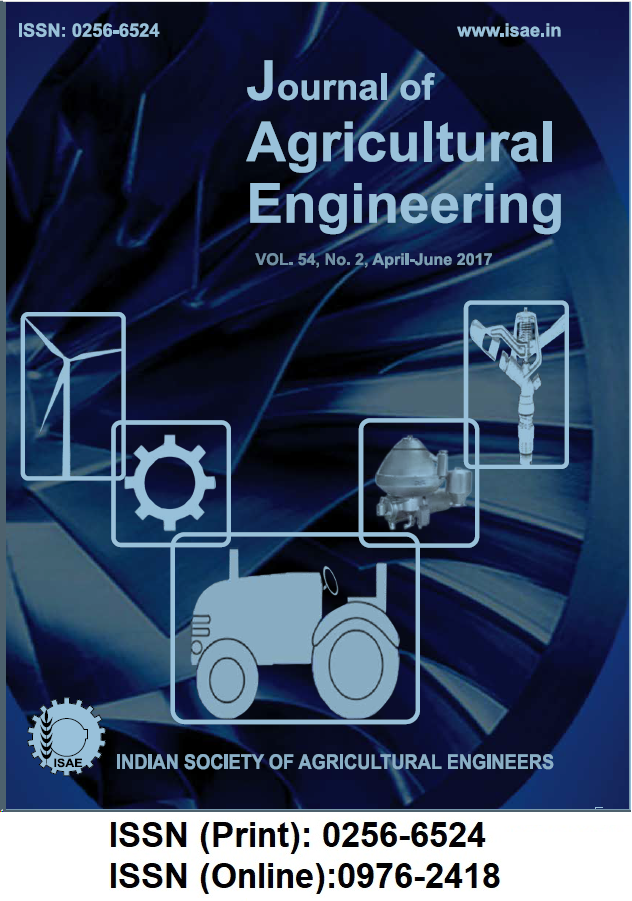Energy Utilization Efficiency and Entrepreneurial Potential of a Solarbiomass Integrated Drying System
DOI:
https://doi.org/10.52151/jae2017542.1625Keywords:
Ginger, turmeric, drying, energy, efficiency, entrepreneurialAbstract
In absence of grid power in most of the production catchments in the North Eastern states of India, coupled with disruptive power situation in areas where it is available, agricultural products are invariably dried under traditional sun drying. Ginger and turmeric with high intrinsic qualities are two major spices produced in a formidable quantity in the region. Truckloads of raw ginger are transported to Delhi and other places, causing huge transit losses. A solar-biomass integrated (IDS) batch drying system was thus designed and developed with a capacity of 100 kg/batch. A compound parabolic solar collector coupled with bio-waste fired combustion and heating assembly was designed and attached to a drying chamber consisting of six trays and a wind turbine on the top to create the necessary draft controlled by butterfly valves and sliding gates. Thin layer drying experiments were carried out for drying of sliced ginger and turmeric. Fluidized bed dryer (FBD), electrical oven (EO) and open sun drying (OSD) were used for comparison. Effective moisture diffusivity in case of turmeric drying was nearly 21% more in comparison to ginger drying. Minimum specific energy consumption (SEC) occurred in IDS, and was 14 and 30 times less compared to FBD and OSD, respectively. Considering total heat available in the plenum chamber and latent heat of vapourization, the IDS showed 36.33% of overall energy utilization efficiency. A run up of 10 years and a break-even of 17.70 % was estimated, reflecting high entrepreneurial possibility of the developed IDS.
References
Akpinar E K. 2004. Energy and exergy analyses of drying of red pepper slices in convective type dryer. Int. J. Heat Mass Transfer, 31, 1165-76.
Akpinar E K; Toraman S. 2013.Estimation of the moisture diffusivity and activation energy in thin layer drying of ginger slices. Int. J. Biol. Biomol. Agric. Food
Biotech. Eng.,7, 415-418.
Arslan D;Ozcan M M. 2008. Evaluation of drying methods with respect to drying kinetics, mineral content and colour characteristics of rosemary leaves. Energy
Convers. Manage., 49, 1258–1264.
Babalis S J; Belessiotis V G. 2004. Influence of the drying conditions on the drying constants and moisture diffusivity during the thin-layer drying of fig. J. Food
Eng., 65, 449-458.
Bena B; Fuller R J. 2002. Natural convection solar dryer with biomass back-up heater. Sol. Energy, 72,75-83.
Chen H; Hernandez C F; Huang T. 2005. A study of the drying effect on lemon slices using a closed-type solar dryer. Sol. Energy, 78, 97-103.
Chua K J; Chou S K. 2003. Low cost drying methods for developing countries. Trends Food Sci. Technol., 14, 519-528.
Crank J. 1975. The Mathematics of Diffusion. Clarendon Press, Oxford, 56-59.
Ekechukwu O V. 1987. Experimental studies of integral-type natural-circulation solar-energy tropical crop dryers. Unpublished Ph.D thesis submitted to Cranfield Institute of Technology, Cranfield, U. K.
Forson F K; Nazha M A A; Akuffo F O; Rajakaruna H. 2007. Design of mixed mode natural convection solar crop dryers: Application of principles and rules
of thumb. Renew. Energy,32, 2306–19.
Geankoplis C J. 2003. Transport Processes and Separation Process Principles. IV Ed., Prentice-Hall of India Pvt. Ltd. , New Delhi, 442-443.
Hollands K G T; Unney T E; Raithby G D; Konicek L. 1976. Free convective heat transfer across inclined air layers. J. Heat Transfer, 98, 189-93.
Jha A K; Deka B C. 2008. Present Status and Prospects of Ginger and Turmeric in NE States. ICAR Research Complex for NEH Region, Umiam, pp:5. http://www.kiran.nic.in/pdf/publications/Ginger_and_Turmeric.pdf
Karathanos V T; Belessiotis V G. 1999. Application of a thin layer equation to drying data of fresh and semidried fruits. J. Agric. Eng. Res., 74, 355–61.
Madamba P S; Driscoll R H; Buckle K A. 1996. The thin-layer drying characteristics of garlic slices. J. Food Eng., 29, 75-97.
Motevali A; Minaei S; Khoshtagaza M H; Hamed A. 2011. Comparison of energy consumption and specific energy requirements of different methods for drying mushroom slices. Energy, 36, 6433-41.
Mulet A; Blasco M; García-Reverter J; García-Pérez J. 2005. Drying kinetics of Curcuma longa rhizomes. J. Food Sci., 70, E318–E323. DOI: 10.1111/j.1365-2621.2005.tb09971.x.
Purohit P; Michaelowa A. 2008. CDM potential of solar water heating systems in India. Sol. Energy, 82, 799-811.
Purohit P. 2009. CO2 emissions mitigation potential of solar home systems under clean development mechanism in India. Energy, 34, 1014-23.
Sacilik K; Keskin R; Elicin A. 2006. Mathematical modelling of solar tunnel drying of thin layer organic tomato. J. Food Eng.,73, 231-238.
Sharma G P; Prasad S. 2006. Specific energy consumption in microwave drying of garlic cloves. Energy, 31, 1921-26.
Zogzas N P; Maroulis Z B; Marinos-Kouris D. 1996. Moisture diffusivity data compilation in foodstuffs. Drying Technol., 14, 2225–53.














